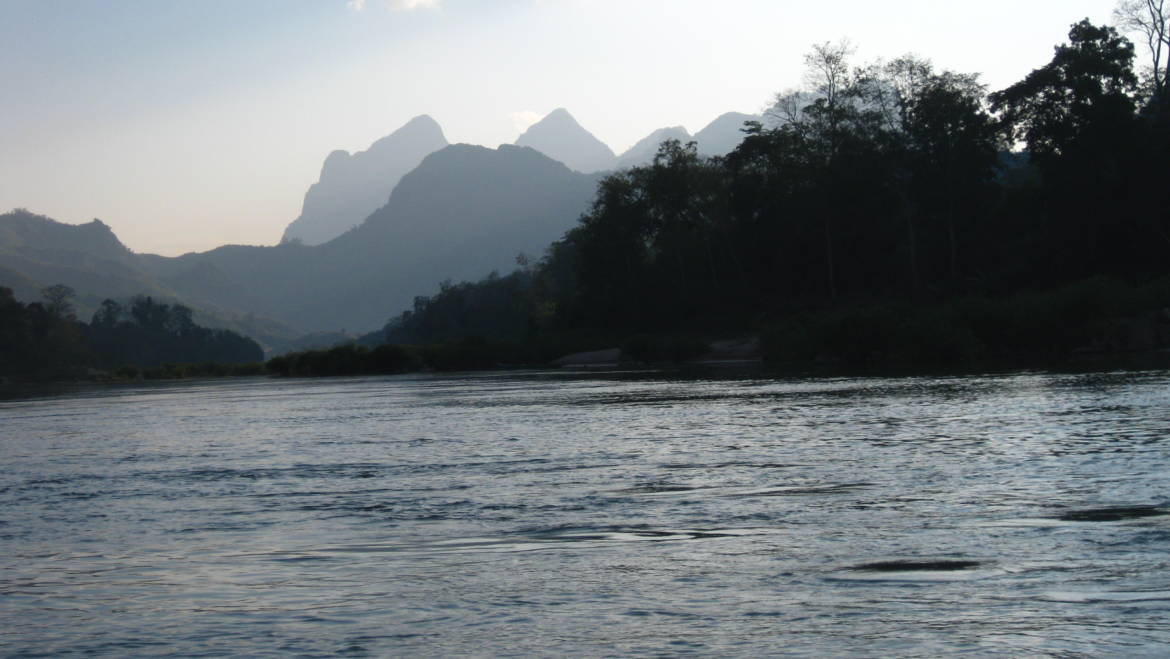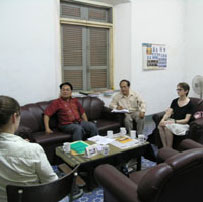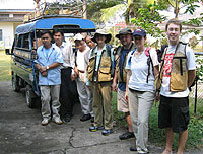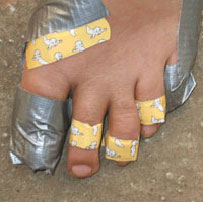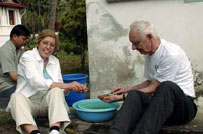In mid-March 2005, the Middle Mekong Archaeology Project (MMAP) started its first exploratory survey along three Mekong River tributaries in Luang Prabang province, in northern Laos. Beginning March 15 and as the month-long survey unfolded, the MMAP team posted frequent updates to this web log, focusing on the daily experiences and challenges of the archaeologist in the field.
Day-to-day life proved to be interesting and fun for this group of U.S., Lao, British, Australian, and Thai colleagues, for a number of reasons. The group was based in Luang Prabang city, a UNESCO World Heritage town of 16,000 with rich cultural traditions, and a lot to experience. The teams that went out daily to locate and record sites along three Mekong River tributaries had much unknown ground to cover–in countryside that was rural and largely undeveloped. Cutting edge technology used to support the MMAP Survey was exciting to use but did not always cooperate. And of course, cross-cultural teamwork was rewarding and (sometimes) challenging.
March 15, 2005
Luang Prabang, Laos
“Baw pen nyang” means “Not a problem!”
The first flock of MMAP group members has landed in Luang Prabang, lugging unliftable luggage filled with laptops, survey supplies, and all sorts of sundry equipment. Luckily no one’s bags were opened at the airport or the authorities would have known for sure that we weren’t the average tourists.
A low anxiety pervaded the first few days due to worries over getting the right visas, when and how the local authorities would receive our team, and some delicate stomachs. Fortunately a legacy of the French colonial period is the baguette, a saving grace for farangs (foreigners) transitioning to eating Lao foods.
On Monday the MMAP team of eight dressed in our finest and walked the quarter-mile to the provincial Department of Information and Culture. Prior to this meeting, the co-directors of MMAP 2005–Dr. Joyce White and Mr. Bounheuang Bouasisngpaseuth–had alerted the rest of the team to the importance of pleasing the Deputy Director, Mr Bounkhong Khutthao, because he would delegate assistance and space for our project. Volunteer Bill Henderson almost plopped down in the Deputy Director’s seat, but disaster was averted when Joyce grabbed his trouser leg and sent him to the correct chair. Much Lao was spoken for the next half hour, while non-Lao speakers tried to look dignified and enthusiastic. Fortunately by meeting’s end, the Deputy Director had granted the last in a series of permissions for the survey project–the conclusion of a process with various Lao PDR government authorities that started four years ago.
Over the weekend, there was much “behind the scenes” work to do. Oversize luggage spit out hundreds of items from cables to first aid supplies to trowels and other survey equipment. We spread out over the entire floor of the common room in our guest house to take inventory and to make sure everything was labeled. It took the Museum’s IT Department (Shawn Hyla) to tame the tangle of cables and electronic equipment, and all the rest of us to wrestle everything into its proper place. Our activities almost caused an international incident with visiting French tourists because our chaos interfered with their evening ‘Beer Lao.” Meanwhile, grad student Olivia Given retreated to a quiet place to revise the MMAP database for the 30th time.
Besides the archaeology tasks, the team is having lots of fun picking up some Lao, including the expression “Baw pen nyang” (Not a problem!) useful when the plan has changed for the umpteenth time or things don’t go as expected. Tomorrow we will see what our new lab space will be like. It is supposed to be on the Palace Museum grounds! Top of page
March 18, 2005
Mekong river bank,
Luang Prabang province, Laos
Lao expression for the day: “khao ji pate” = Lao hoagie
Yesterday the MMAP team dealt with power issues (as in electricity). We arrived bright and early at our assigned lab space at the Palace Museum. Laptops, printer, and ancillary screen were set up so Museum Director Sisavath Nhilatchay and Deputy Director Vanpheng Keopannha could see the work done so far in developing the MMAP database. The demonstration was well received, but we soon discovered that using the laptop with the large screen attached was a “shocking” experience–unfortunately the outlets weren’t grounded.
Much discussion followed among the tech-savvy Shawn, Olivia and Ben. The laptops would be OK with the high capacity rechargeable batteries we brought, but the team didn’t want to take a chance using the printer or large screen with the ungrounded outlets. So Bounheuang took the tech team off to the Chinese market (where all things practical can be purchased) to buy a car battery to daisy-chain with our solar panels. Five hours later, using a partial charge on the battery, the tech team was successful in powering up. Meanwhile a local electrician worked on the wiring in our building: two hours after battery/solar power was up, we also had a new hole in the lab wall with ground wire attached to a metal pin outside. We are now set up for any occasion, with multiple power sources!
Today we trek along the Mekong river bank on our first day of site surveys and technical run-throughs. Eight of us slither down the embankment carrying all three teams’ GIS equipment in backpacks and gear vests. We rediscover 2 sites seen by Bounheuang and Joyce in 2001 and use them to practice with the GPS and other equipment. Returning to the truck just before a downpour in the late afternoon, we weave our way through gardens and dense underbrush, once dodging a burning swidden. Needless to say, the shower at the end of the day feels like heaven.
By the way, our lab space is in a small airy building just next to the Palace Museum, with two geckos in residence on the ceiling. An old tennis court outside is ideal for drying artifacts after we wash them. Shawn also got in some time on the court, playing “kataw” (kind of like hacky sack with a rattan whiffle-ball) with the Museum Director’s kids, who live on the Museum grounds.
Tomorrow we will download our day’s data and prepare for Sunday’s trek to a new cave site. Top of page
March 19, 2005
Luang Prabang
Lao expression for the day: “Sabaidee” = all-purpose Hello (Welcome)
Today is spent in our Museum lab space, downloading and organizing Friday’s data from our trek along the Mekong. But as we leave the Museum grounds in the evening, Ben and Kanda decide that they don’t want to quit work yet.
As Joyce and Bounheuang discovered in 2001, Lao markets are another place to do archaeological research. Amidst traditional crafts laid out on vendor’s mats at the Luang Prabang night market — paper lanterns, woven and embroidered silk, cotton clothing and purses, teapots, bamboo flutes, kitchen knives — Ben and Kanda go on the hunt for the stone adzes and other artifacts that are often there too. Despite strange looks from tourists and vendors, they photograph every stone tool for sale tonight, with a centimeter scale laid alongside for measurement.
Followup research is in store later in the week, after some analysis of tonight’s finds on Ben’s part.
March 20, 2005
Where the Mekong meets the Seuang,
Luang Prabang province
Lao word for the day: “khao niaw” means “sticky rice”
We get an early start today because last night we organized our packs, with GPSs, cameras, fluorescent flags, water, trowels and so forth (and toilet paper, the most important thing in an archaeologist’s field pack!) It’s a beautiful day as we start out along the river–sunny and hot with no rain in sight. We’re out today to do another test run with equipment and field database, only this time we were hoping to see a cave site along the Seuang River. But as happens often with the best of plans, we find something else.
The first site we see is a 17th century stupa (a stone building in which a sacred object rests) on a hill–not exactly from the Middle Holocene period of prehistory!
At our second site, we collect a bag full of pottery sherds from prehistoric ceramics closer to the time period that interests us. It quickly becomes obvious who has “eyes” – the ability to spot ancient artifacts lying on the ground. Co-director Bounheuang is really outstanding in this area.
On a hillside above the Mekong, we eat a delightful picnic lunch of sticky rice and various tasty local dishes, everyone sharing and enjoying the food and the spectacular scenery. Then of course it rains for awhile, giving Shawn and Olivia the chance to show off new sneaker-skiing skills, as they slide down the muddy trail. We get back to the lab just in time to greet Katherine Arrell, a geographer arriving from England to join the team.
Equipment testing has gone well today, so tomorrow we split into three teams to start daily exploration of each of the three rivers we came to investigate–Nam (River) Ou, Nam Khan, and Nam Seuang. Top of page
March 23, 2005
Ban Mak Hat Village,
Luang Prabang province
Lao expression for the day: “Kopjai lai lai” means “Thank you very much”
It’s important to ask for permission if you’re an archaeologist in Laos. There’s no way the MMAP teams can find new archaeological sites without going to villages first to ask for permission.
Also, one of first phrases non-Lao team members learn is “Kopjai lai lai” (“Thank you very much.”) We use the phrase often in the villages because much of what we are able to learn about new sites starts with our visits there.
The routine is that we drive to a village and the Lao team members from the Department of Information and Culture negotiate with the headman on our behalf. We must ask permission from the headman to walk through their land and for their assistance in finding sites. Lao team members explain what archaeologists do, show examples of the kinds of things we are looking for, and reassure the villagers that the effort is worthwhile for Laos and for their village.
If the headman says yes, he helps find one or two men to show us the sites they know of. Villagers know the area (and we don’t), so we hire at least one villager to go with us. Sometimes the headman isn’t there the first day we pass through, so we have to move on to another village and come back another day.
Yesterday, the Nam Seuang team found that there are even more good reasons to ask for permission. At the end of the day the team wanted to quickly check out a cave near the road. As they were about to enter the cave, someone called from a distance. It turned out to be the local policeman. Bounheuang quickly got us out of the cave and adroitly explained that we were archaeologists and that we were very sorry we had not asked for permission first. All of us went off to the truck immediately.
Tomorrow there are more villages to visit and the possibility of new adventures. We also welcome a new team member, Soi Onsuwan Eyre, who arrived from Thailand today. Top of page
March 25, 2005
Somewhere in Luang Prabang province
Lao vocabulary for the day: “samsip nathi” = 30 minutes;” “ngai” = easy
We are learning that “30 minutes” means an hour or more and “easy” might well mean “a little less than impossible”.
When a MMAP team goes to a village, part of the discussion with the headman and the villagers is about the amount of time and the distance to possible sites. Today when the headman tells the Seuang team about cave sites we might visit, he says that there is a site about thirty minutes away that is easy to reach.
An hour later the team is still huffing and puffing up what seems like a vertical incline, complete with jagged limestone boulders, loose rocks, and slippery gravel. Sometimes stray boulders come loose and crash down around us. One team member grabs a branch to help pull herself along and, as the rotten wood breaks, has a heart-stopping moment and the vision of a long fall. We can see our villager guide high above us, squatting atop a boulder in his flipflops and enjoying a cigarette (probably a Marlboro that Joyce bought in the duty free shop in LA to share with villagers). He patiently waits for us to catch up as we struggle along in our engineered footwear. And we still have some distance to go before we actually get to the cave.
Meanwhile, on the Khan team, Katherine remembers the times in England when she refused friend’s offers to go rock-climbing as she moves spread-eagled across a cliff face. When her team finally pulls themselves up over the last boulder, they can see the mouth of the cave. The outer opening is fairly large, but the entrance to a connecting inner cave is tiny. Lao colleagues slip through, but they worry about the rest of the team. Western bodies are wide compared to the Laos’, but with some pushing and dragging everyone gets into the chamber.
Sometimes all our efforts are repaid with finds of artifacts–to everyone’s jubilation–but sometimes not. One team finds only remains of bamboo beds and weaponry left over from “the American War” (known to Americans as the Vietnam War).
Tomorrow we discuss the medical uses of duct tape. Top of page
March 27, 2005
Luang Prabang province
Lao vocabulary for the day: “thong ruang” (literal translation: “falling stomach”)
Archaeological fieldwork has its health considerations, and remote Laos takes more forethought than the average trip.
First there is the preparation. Joyce sent most of the Philadelphia team members to Penn Travel Medicine where we got a long list of inoculations and meds from Jim Branagh, our extroverted guide to healthy living abroad. If the list itself was not enough to put us off, there were also “do’s” and “don’ts” of what to eat (no uncooked veggies or unpeeled fruit) and drink (no ice, tap water, or milk that might not be pasteurized). Jim came close to suggesting that we all take daily showers in insect repellent.
MMAP team members left home with arms tender from inoculations–typhoid, rabies, flu, hepatitis A and B, pneumococcus and tetanus for those Philadelphians who had lived the most sheltered lives, and a smaller brew for more travel-experienced team members. We arrived in Laos with our own personal pharmacies–anti-malarial pills, Immodium, and antibiotics at the very least. Some of us brought bug repellant-infused shirts and socks from specialty camping stores in addition to the usual lotions and sprays. Beth (A.K.A. “nurse Beth”) packed first aid kits for each field team.
Now we’ve settled into real life in Laos. After about half a day of culinary caution, most team members find themselves following Joyce’s more relaxed list of “do’s” and “don’ts”. A typical morning meal of “pho” (prounced “fer”, noodle soup) is just not quite right until flavored with fresh lettuce, mint, bean and herb toppings. We can’t resist the fresh fruit shakes (made from fruit, ice and milk in a blender) or the occasional tasty morsel from a street vendor’s stall.
We find that when we eat in local restaurants that have a lot of customers, and follow Lao colleagues’ suggestions about local foods to eat (or not to eat), we seem to do pretty well. Just for the record, two team members got the worst “falling stomachs” after eating at a restaurant catering to westerners!
Sometimes innovation is called for. When Shawn’s tender winter feet develop an impressive array of blisters after a few days in the field, he dutifully applies ointments and bandaids from one of the first aid kits. But soon volunteers Bill, Beth and Barbara become puzzled by the daily disappearance of the lab’s duct tape. Meanwhile, those of us on the Seuang team watch–every morning as we drive to the next site–as Shawn meticulously applies duct tape to all of his toes and other body parts chafing from the unaccustomed wear of backpacks, hiking shoes, and other equipment.
Use of local herbal remedies is another good example. One day, Bill ends up with a blood-covered hand after he grabs a thorny tree branch to get up a steep trail. Before Bill can get out the bandaids, the village guide applies a “bai yah farang” poultice made from nearby plants -instant coagulation!
Beth also flouts conventional treatment (sorry, Jim), when she decides not to shave a patch of hair from Joyce’s head to treat a head wound from a falling stick. She imagines Joyce at her Siam Society lecture in April, looking a little odd with a bald spot, and votes for dignity instead. Happily, Joyce recovers nicely.
So far we’re all doing well as far as health and well-being is concerned. If you don’t hear from us again on this topic, it’s because we are experiencing nothing more than the typical blisters, cuts, bruises, insect bites, pulled muscles and “falling stomachs” expected by any archaeologist working in Laos. Top of page
March 31, 2005
National Museum, Luang Prabang city
Lao word for the day: “A sa su mak” means “volunteer”
A Day in the Life of a Volunteer…
What do you mean, breakfast at 6:25? We find that our day really starts about 4 AM, when the monks next door at Wat Manorom arise to bell ringing, cymbals and drumming and begin their early morning obligations. We soon get used to the neighbors: we either sleep through it all or doze off again until our usual 6 AM rising time.
It’s a 5-minute walk to our al fresco breakfast place, where members of the MMAP team are welcomed as “regulars”. Here we sit and eat and watch the morning rush hour- mostly motorbikes and bicycles–as Luang Prabang parents take kids to school and go off to work. Then we’re off to our own workplace at the National (Palace) Museum, in a small utility truck bearing a marker 13P, or thirteen-person capacity. (Eight MMAP team members barely fit on the facing bench seats.)
Most days we asasumaks have lots of opportunity to observe the culture around us.
We observe archaeologists’ eating habits and try to adapt. Eating only bread or “pho” (noodle soup) for breakfast seems odd when there are omelettes and other good things on the menu, but we figure it out after a few days. It appears that it’s best to eat the quickest thing the cook can make, so the archaeologist can start early. We volunteers are thankful that the restaurant doesn’t open until 6:30. If it opened any earlier, we’d be up with the monks.
The same correlation applies to Joyce’s dinners of chocolate bars and her ability to move seamlessly from a full day in the field to a full evening of downloading data, etc. We may forego a formal sit-down dinner, but we at least have our yogurt, crackers and Beer Lao.
We asasumaks struggle with the language barrier. What does Joyce mean when she hands Beth a bag of artifacts and asks her to “photograph the lithics with the bulbs of percussion and striking platforms pointing downward”? It’s hard to know when to eavesdrop on the archaeologist conversation. Was Ben speaking English or was it Thai with an Australian accent? Is it even English at all when the archaeologist slips into shop talk at the dinner table?
Bill, the most experienced volunteer, often translates for Barb and Beth. We learn to watch his body language when an archaeologist speaks, to see if we should get excited about a great ceramic find or commiserate over a so-so site.
When the field teams leave for the day, we volunteers are on our own. Despite fantasies of eating bagels with Philadelphia cream cheese and sleeping in, we settle into our daily chores of updating the database and scrubbing and labeling artifacts.
Barb and the database have a love-hate relationship. She has made it her personal goal to whip it into shape. We often hear her admonishing “What are you doing now?!” or “That’s not what I wanted you to do!” in her best retired-schoolteacher voice, and we expect the computer to reply any day now.
Occasionally our efforts accomplish more than just processing the artifacts. Bill’s scrubbing reveals a pattern of the same faint decorations on many pottery sherds from one site. He matches up the decorative patterns, then sketches what a section of the pot might look like. Much delight and discussion when the field teams return in the afternoon!
It’s nearly dark by the time we begin our walk home from the museum with the MMAP team, heading out of the gates into a street now filled with “night market” vendors. We do a little recreational shopping and regroup for dinner. Then it’s early to bed with yet another day of similar activities in store tomorrow for the asasumaks …….. and what day is this anyhow–Thursday? Sunday? Top of page
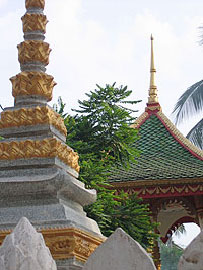 April 15, 2005
April 15, 2005
Vientiane, Laos
Lao phrase for the day: “Sabaidee Pi Mai!” means “Happy New Year!”
Many apologies for the delay since we last posted to this web log. The last two weeks have been hectic as the 2005 MMAP Survey has come to a conclusion. Many promising sites have been found and several are good excavation possibilities. The final day for team trekking was on April 8th, and we’ve been caught up in a flurry of activity since the end of March- labeling, photographing and boxing artifacts; packing equipment and supplies; moving out of our “home away from home” lab at the Museum; saying goodbye as team members left to get back to their busy lives. Those who remained to the end – Beth, Joyce, Kanda, Bounheuang, Soi, Vanpheng, Boungnalit, and Kone Vi Lay–scrambled to put together an April 13th end-of-season exhibit for Luang Prabang Province officials, who were collectively curious about just what the heck we’d been doing since March 15th.
We empathize with the officials’ curiosity. They may have seen (or heard about) some of the classic scenes that the MMAP team remembers as typical in “a day in the life of the archaeologist”:
–One or more archaeologists thrusting arms out of the sides and/or back of a transport truck, pointing GPSs toward elusive satellite signals as the truck bounces them heartily down a rutted road.
–Joyce standing in the middle of a village, decked out in bright blue leg brace, “amazing archaeologist” baseball cap, mustard-yellow surveyor’s vest with pockets full with digital camera, GPS, Bluetooth, compass, assorted pens and pencils, notebook, etc. As she intensely focuses on entering data into her handheld GIS, Bounheuang is fielding relevant questions from the villagers: Where is her husband? How old is she? How many children does she have?
–Ben mastering the handheld GIS “reboot” procedure, using a stylus to press a tiny “lock” button with one hand, a finger on the other hand to push the “on” button and his teeth to remove the battery -as he follows the village guide down a steep swidden field.
–Bounheuang using his amazing “schmoozing” skills: convincing the villagers that helping us find flaked stone artifacts is essential for the future of Laos.
Joyce and Beth are now in Vientiane, preparing for the April 20th MMAP exhibit for Lao officials in this capital city, and staying in a guest house in the midst of the city’s Buddhist temple district. It’s Pi Mai–Lao New Year–a four-day festival that requires that we develop devious ways to get from our guest house to restaurants and the internet café without getting water-soaked. Cleansing the Buddha statues with water has a parallel activity on the streets -fun-loving kids dowse themselves and every passerby with buckets of water, hoses, water pistols, or Super-Soaker guns. No one is exempt, so we either sneak down less-traveled alleys, or cover everything important with plastic bags and hope for the best!
It is a joyous end to a very successful field season. We can only wish that we have the same great teamwork and success in the next phase of MMAP research in Laos. Top of page

